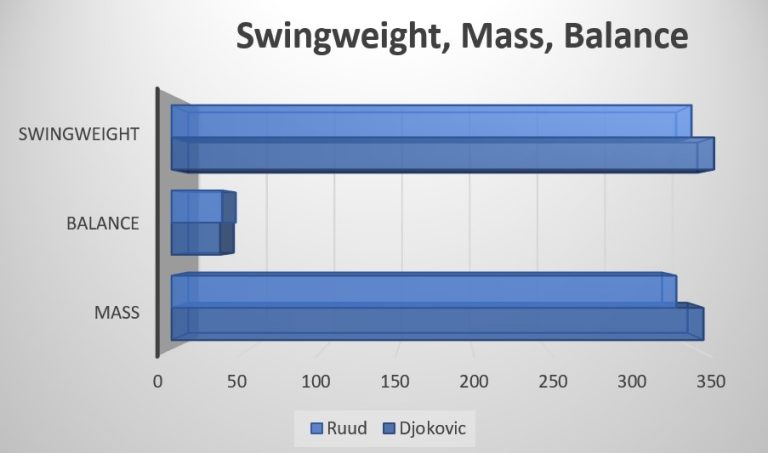The Roland Garros 2023 Finals are poised to be not just a thrilling encounter but a historic one as well. Seasoned champion Novak Djokovic is aiming for his record-breaking 23rd Grand Slam title, which would surpass his long-standing rival Rafael Nadal’s tally of 22. The rising star Casper Ruud, on the other hand, is seeking to make history as the first Norwegian to clinch a Grand Slam singles title. This electrifying clash promises a fascinating blend of styles and strategies on the red clay of Roland Garros.
While strategies, skills, and fitness play significant roles in a match, the choice of equipment, particularly the tennis racket, can greatly influence a player’s performance. Let’s delve deeper into how Djokovic’s and Ruud’s respective racket choices are tailored to their playing styles and the potential effects on this crucial face-off.
Djokovic, known for his control and endurance, uses an older Head mould with 95 inch head size and a lot of weight added. It’s characterized by a higher swing weight and overall mass, which provides enhanced control and stability. This implies that Djokovic, wielding a heavier racket, can maintain accuracy and steadiness, even during long and demanding rallies. His racket’s characteristics result in a higher ceiling coupled with control, allowing him to expertly navigate high-pressure situations and adapt his game to various playing conditions.
The heavier mass of Djokovic’s racket also contributes to an effective counterpunching strategy. It allows him to absorb and redirect the power coming from Ruud’s heavy strokes, neutralizing the Norwegian’s relentless forehand attacks. This racket setup is especially advantageous on a clay court, where Djokovic can capitalize on slower game speed to position himself strategically and orchestrate the flow of the rally, preventing Ruud to dictate with his heavy topspins shots.
On the other hand, Ruud’s Yonex Ezone 100 racket is known for its stiff frame and larger head size. It’s weighted and extended, with higher balance point. It offers less control compared to Djokovic’s racket but compensates with a higher power-spin ceiling. The stiffer frame enhances power generation while the larger head size increases the sweet spot, giving Ruud an edge in topspin generation. His racket’s lighter weight also allows for quicker swing speeds, which aids in producing high-spin shots that are difficult for opponents to return.
The Yonex Ezone 100’s properties cater well to Ruud’s playing style, where power and spin are pivotal. The Norwegian relies heavily on keeping his opponents pinned behind the baseline, as he maneuvers them around the court with his powerful forehand. However, the trade-off is a lower control ceiling, which might limit his adaptability in the face of Djokovic’s varied shot selection and precision.
Hence, while Ruud’s racket configuration emphasizes power and spin, it poses potential limitations in terms of control, making it challenging for him to adapt to Djokovic’s strategy changes. Conversely, Djokovic’s racket setup provides a higher control ceiling, facilitating better maneuverability and accuracy.
However, Djokovic’s proficient counterpunching ability allows him to effectively escape the clutches of Ruud’s dominant forehand. Armed with his notable defensive skills, Djokovic consistently looks to seize control of the point as swiftly as possible, using his potent serve and return to wrestle the momentum from his opponent.
The slower pace of clay courts is likely to test both players’ endurance. Djokovic’s vast experience in sustaining through lengthy matches could tip the scales in his favor. Ruud’s initial game plan might be potent, but Djokovic’s notorious defensive prowess could neutralize the Norwegian’s advantages.

Despite the physical test that awaits both players, the mental aspect of the match is also paramount. Djokovic’s extensive experience in Grand Slam finals provides him an edge in handling the intense pressure of such crucial games. However, with Ruud’s growing maturity on the tour, he could possibly rise to the occasion and deliver a notable performance.
While Djokovic has admitted to carrying minor injuries, these have yet to significantly impede his performance. Nonetheless, any limitations could be disadvantageous on the demanding clay court.
In conclusion, the Djokovic-Ruud match is an intriguing clash of racket technologies and styles. While Djokovic’s control and stability might dominate the slower clay court, Ruud’s power and spin could disrupt Djokovic’s plans. It’s a dynamic showcase of how tennis equipment choices significantly influence gameplay and performance.